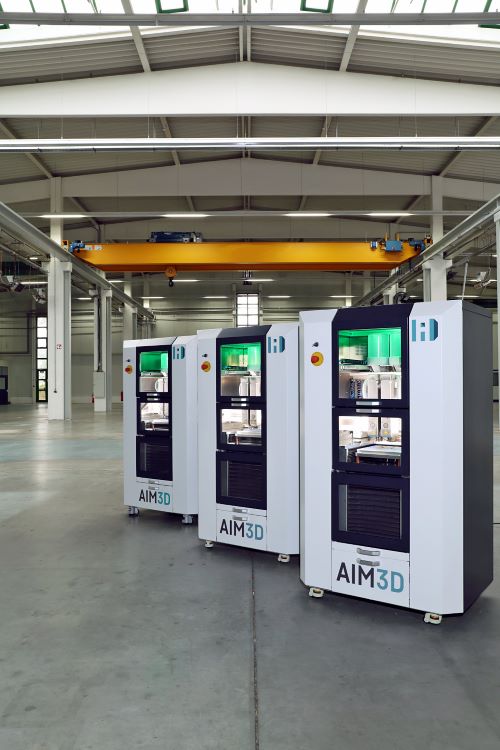
At the Rapid.Tech 2023 trade fair in Erfurt (Germany), AIM3D – a supplier of 3D printers based on the CEM (Composite Extrusion Modelling) process – presented its ExAM 255 3D printer as the highlight of its trade fair presence. The ExAM 255 system combines high precision of the 3D printed components with fast printing speeds for additive manufacturing. As a multi-material 3D printer, the ExAM 255 can print metal, plastic and ceramic materials and enables a continuous digital process chain of a 3D printing process.
The ExAM 255 multi-material 3D printer can be deployed for a variety of materials (metals, plastics, ceramics) and processes (hybrid components). Compared to the powder bed process or other 3D printing processes that use filament materials, parts made with the CEM process can achieve tensile strengths which come close to conventional thermoplastic injection moulding methods. There are clear cost savings with 3D printing when commercial pellets are used instead of filaments. Thanks to the CEM process, cost savings of up to a factor of 10 can be realised with pellets.
Competitiveness of 3D printing with pellets
The use of pellets when 3D printing with plastics has proven to be competitive, especially in the case of components made with fibres. In general, there is a difference between fibre-reinforced (GF) and fibre-filled (the use of short fibres). Two materials that are of particular interest due to their widespread use in the plastics processing industry are PPS GF40 (polyphenylene sulfide) and PA6 GF30 (polyamide). These materials combine excellent mechanical properties with media and temperature stability. The ExAM 255 uses commercially available pellets, such as those used in injection moulding. This results in very competitive 3D printing costs using the CEM process, compared to conventional manufacturing strategies. The material cost savings for a processed component is between 80 and 96%, depending on the material group. Such components generally have a higher density and exhibit high tensile strength. Furthermore, this results in a high degree of flexibility for the processor, since the material does not have to be modified. Identical, certified material means the same or comparable properties, such as thermal conductivity, media resistance, damping, mechanical properties, shrinkage or density. In addition, long-fibre reinforcement with fibre lengths of up to 3 mm is possible with a filling level of up to 60%. Another characteristic of the ExAM 255 system is reflected in the material cut of PA6 GF30: it offers high consistency of fibre orientation with the extrusion paths (+45º/-45º filling/infill printing). Extrusion path control can be used during printing to optimise the strength of the component. Cost-effectiveness is also due to the low machine hour rates and the high energy efficiency of the 3D printing system. In total, these features of the ExAM 255 machine offer enormous benefits in 3D printing, since polyamide applications are very widespread and this is the first time that a 3D process is available for these applications at an attractive price.
High precision 3D printing
The accuracy of a 3D printer is paramount for processors. The ExAM 255 achieves accuracies of up to 25 µm, this of course depends on the build speed. The degree of precision in the component results from the design of the machine: two granulate extruders work in the ExAM 255’s build area, each are supplied with material via a separate feedstock. The build area itself measures 255 x 255 x 255 mm and can be passively heated up to 60ºC. AIM3D specifies a build rate (with a 0.4 mm nozzle) of up to 40 cm³/h, depending on the material selected.
Multi-material spectrum ensures a high degree of flexibility
The flexibility of the printable materials plays a central role when deciding which machine to buy. As a unique selling point, the ExAM 255 covers a very wide range of materials. This includes steel, titanium, non-ferrous metals and hard metals in the metals material group. In the case of plastics, the types of plastics in pellet form that can be printed are identical to those known from conventional processes. There are also ceramic applications. In the ExAM 255, the feedstock is fed via material containers arranged in pairs above the ExAM 255’s build area. This arrangement enables multi-component printing of polymers, but also combinations of metal, plastic or ceramics. The options offered by this system technology also enable a combination of processes with hybrid components. In this case, one component can be manufactured in a conventional way and a second component is printed. This results in many perfect solutions for almost every industrial application.
References from institutes and industry
In addition to numerous institutes that deploy the ExAM 255 for rapid prototyping and materials research, well-known industrial customers also use the ExAM 255 multi-material 3D printer. These include industrial users such as Brose, Schunk, Schaeffler and BASF. These operators focus on small and medium-sized series production using 3D printing. The acceptance of the ExAM 255 by processors is strategic and is due to the use of series material. This greatly reduces development times and the printed components have similar component properties and appearance to series production parts. Alternative component designs with bionic properties and lightweight construction strategies can also be tested using the ExAM 255. Another significant advantage is the “one-shot technology”: a component is created successively without any assembly work. This can also include integration. A conventional component can be structurally and functionally optimised using an additive manufacturing strategy by means of reengineering. The special appeal of the CEM process is the material-hybrid and hybrid-process 3D component geometries enabling maximum flexibility and freedom to design. In terms of cost savings, flexibility, precision and build rates, the ExAM 255 offers ideal conditions for developing additive manufacturing as a supplement to conventional manufacturing strategies.

 iConnectHub
iConnectHub
 Login/Register
Login/Register Supplier Login
Supplier Login


























